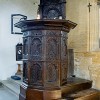Weymouth was not the first seaside resort to have Bathing Machines. Prior to their appearance here in the 1770’s, they were already a feature at Scarborough and Margate but those resorts did not enjoy the patronage of King George III.
The earliest type of bathing house was a static hut; the revolutionary idea of putting the hut on wheels came along in the mid 18th century and the mobile bathing hut became known as a bathing machine. It could be drawn out into the sea by a horse to avoid the bather having to make an exhibition of themselves walking down the beach.
King George III first dipped his toe in the sea at Weymouth on the 7th of July 1789 in the company of a select group of lady bathing attendants. Apparently it was a great surprise to the king when a band concealed in a neighbouring machine, struck up God Save Great George our King as soon as he ducked his head under the water.
The first Royal Bathing Machine was octagonal in design and in 1791 it was replaced by a larger and more extravagantly fitted-out machine. Altogether three bathing machines were available that year for the exclusive use of the Royal Family. The original machine continued to be used on Weymouth beach until 1916.
A newspaper report from 1791 describes the vehicle thus: “The King’s Bathing Machine is in the form of an oblong at its base, and painted white, with the panels blue and red cornices, but is destitute of lining. The outside, at the top, forms a semi-circle, on the extremity of which stands upon a pole of about two feet in length, the Crown; and on the other, the British Flag on a pole or standard about ten feet high; on the front is painted the King’s Arms.”
Another newspaper reported that the Queen had decided to try the effects of bathing, so another machine had been newly painted and fitted for her use. This conflicts with other reports suggesting Queen Charlotte showed no enthusiasm for sea bathing; the Royal Princesses however, were regular “dippers.”
When the King came to Weymouth in 1792 his bathing experience was greatly improved by the introduction of the Royal Floating Bathing Machine, which gave more privacy to the Royal Family. This was a large structure resembling a house-boat or a floating dock, with dressing rooms and three large baths. It allowed the user to bathe in complete privacy and could be used in pretty much all weathers; it was covered by a roof and sea water flowed in through grills at each end. At one end of the structure were the Royal Bath and Royal Dressing Room and at the other end were baths and dressing rooms for the use of the king’s guests. It was first used on the 24th of August 1792.
When not being used for bathing this Floating Bathing Machine doubled as a Royal Landing Stage and was moored alongside Weymouth Pier. The dressing rooms provided the family with the opportunity to smarten up their appearance before coming ashore after their frequent trips to sea with the Royal Navy.
The King first visited Weymouth in 1789. A letter written at Gloucester Lodge, Weymouth on the 13th of July 1789 by Fanny Burney to her father illustrates wonderfully how the inhabitants of the town felt about their Sovereign being amongst them. She reports “The loyalty of all this place is excessive; they have dressed out every street with labels of ‘God save the King’: all the shops have it over the doors; all the children wear it in their caps, all the labourers in their hats, and all the sailors in their voices, for they never approach the house without shouting it aloud, nor see the King or his shadow, without beginning to huzza, and going on to three cheers.”
The three luxurious Royal Bathing Machines of 1791 did not survive after the last of the Royal visits in 1805, although machines of the original design both octagonal and rectangular continued in use for more than a century.
In 1810 a local byelaw decreed that no one was to “bathe in any manner than by means of a Bathing Machine upon the Sea Sands, or in the Harbour, or Back Water within the town”. In 1864 a byelaw was introduced to stop the use of Bathing Machines on a Sunday after 10 a.m. This law required residents to be allowed the use of a machine for a charge of 6d, whereas visitors had to pay 9d. All machines had to be fitted with a looking glass and carpet and two hand towels for each person and also a pair of drawers for the use of each gentleman. Males were permitted to bathe nude before 8 am, and there had to be a space of 50 yards between machines used by men and women.
Two much larger bathing machines came to the beach in 1890, these had several cubicles. These larger machines, one for men and one for women, had very large wheels and the authorities ordered that they be kept in deep water. Around this time there were many complaints about the wearing of “proper bathing drawers”.
Fanny Burney, writing from Weymouth in 1789, tells her father that she had difficulty keeping a straight face when observing the ladies bathing apparel: flannel dresses, tucked up, with no shoes or stockings, with bandeaus and girdles. King George III preferred to bathe in the nude.



